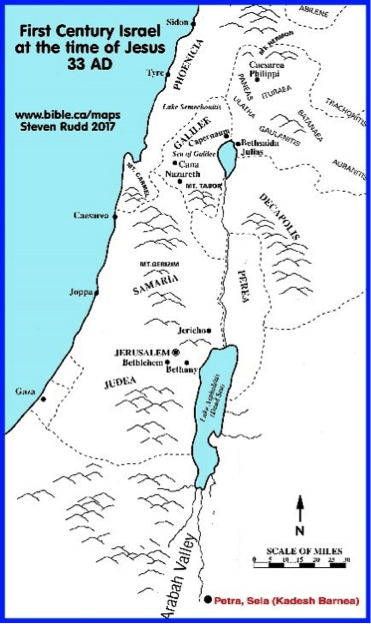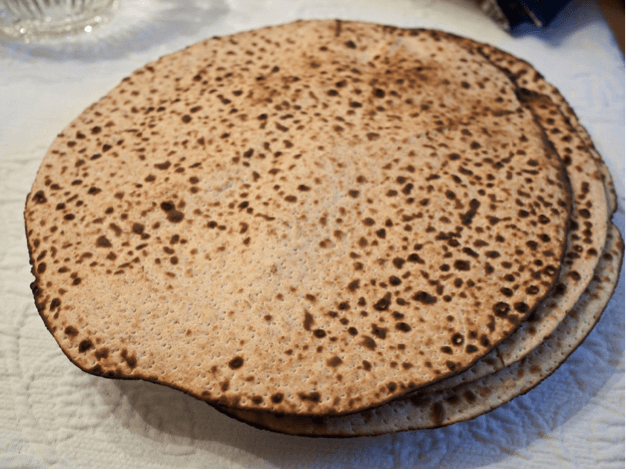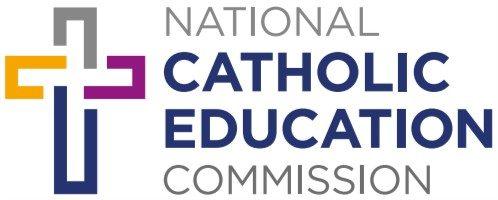The Passover with the Disciples
17 On the first day of Unleavened Bread the disciples came to Jesus, saying, “Where do you want us to make the preparations for you to eat the Passover?” 18 He said, “Go into the city to a certain man, and say to him, ‘The Teacher says, My time is near; I will keep the Passover at your house with my disciples.’” 19 So the disciples did as Jesus had directed them, and they prepared the Passover meal.
20 When it was evening, he took his place with the twelve; 21 and while they were eating, he said, “Truly I tell you, one of you will betray me.” 22 And they became greatly distressed and began to say to him one after another, “Surely not I, Lord?” 23 He answered, “The one who has dipped his hand into the bowl with me will betray me. 24 The Son of Man goes as it is written of him, but woe to that one by whom the Son of Man is betrayed! It would have been better for that one not to have been born.” 25 Judas, who betrayed him, said, “Surely not I, Rabbi?” He replied, “You have said so.” 26 While they were eating, Jesus took a loaf of bread, and after blessing it he broke it, gave it to the disciples, and said, “Take, eat; this is my body.” 27 Then he took a cup, and after giving thanks he gave it to them, saying, “Drink from it, all of you; 28 for this is my blood of the covenant, which is poured out for many for the forgiveness of sins. 29 I tell you, I will never again drink of this fruit of the vine until that day when I drink it new with you in my Father’s kingdom.”
30 When they had sung the hymn, they went out to the Mount of Olives.
New Revised Standard Version Bible: Catholic Edition, copyright © 1989, 1993, 1995 the Division of Christian Education of the National Council of the Churches of Christ in the United States of America. Used by permission. All rights reserved.
What to do with this educator’s commentary
This commentary invites you as a teacher to engage with and interpret the passage. Allow the text to speak first. The commentary suggests that you ask yourself various questions that will aid your interpretation. They will help you answer for yourself the question in the last words of the text: ‘what does this mean?’
This educator’s commentary is not a ‘finished package’. It is for your engagement with the text. You then go on to plan how you enable your students to work with the text.
Both you and your students are the agents of interpretation. The ‘Worlds of the Text’ offer a structure, a conversation between the worlds of the author and the setting of the text; the world of the text; and the world of reader. In your personal reflection and in your teaching all three worlds should be integrated as they rely on each other.
In your teaching you are encouraged to ask your students to engage with the text in a dialogical way, to explore and interpret it, to share their own interpretation and to listen to that of others before they engage with the way the text might relate to a topic or unit of work being studied.
Structure of the commentary:
Text & textual features
Characters & setting
Ideas / phrases / concepts
Questions for the teacher
The world in front of the text
Questions for the teacher
Meaning for today / challenges
Church interpretations & usage
The World Behind the Text
There are two ‘worlds’ behind the text: the world that produced it and the world of the time in which it is set.
The two worlds behind this text
a. The world of the author and their community
Matthew adds to what Mark says in his version of the Last Supper: “This is my blood of the covenant which will be shed for many” by saying, “for the forgiveness of sins” (Mt 26:28). For a community in turmoil, Matthew presented the breaking of the bread as a healing and nourishing event. Jesus’ sacrifice was a merciful act for many.
b. The world at the time of this text
(i) Characters:
Jesus
Matthew gives Jesus the title ‘Son of Man’.
Matthew also has Judas call Jesus Rabbi
The Twelve
Matthew follows Mark in naming the people he eats with as the inner circle of disciples, the twelve. The twelve are reminiscent of the 12 tribes of Israel, restored in the kingdom of God. They do not comprise the total discipleship group.
Judas
Matthew is the only Gospel which explicitly names Judas as the one who would betray Jesus. Once Jesus has made this pronouncement that someone will betray him the disciples all ask, “Surely not I, Lord”? Even Judas asks, but interestingly he is the only one to use the title ‘Rabbi’ for Jesus. He continues his deceit and feigns innocence. Imagine sitting to a meal with someone you knew had arranged such a fate for you! Jesus says to him “You have said so”, not condemning him even at this moment.
(ii) Geography:
The story takes place in Jerusalem. Matthew’s account would indicate that Jesus has been in Jerusalem since ‘Palm Sunday’, about 5 days. Jerusalem would have been full of Jews celebrating the Passover. The Temple Mount would have been full of people, purchasing and sacrificing unblemished animals at the Temple.

Mount of Olives
After singing together and praising of God at the end of the Passover ritual, Matthew tells us they go off to the Mount of Olives.
(iii) Customs or rituals:
Passover
Whilst there are clear references to the Last Supper being a Passover meal, what Matthew recounts is not a typical 1st Century experience. Indeed, the entire passion occurring during the Festival of Passover his unlikely; historical inaccuracies (trials during the season were prohibited and families usually celebrated the Passover together) and literary inconsistencies (John says it was before Passover) result in most scholars concluding that the placement of the event at Passover is theological in intent rather than historical. That aside, for Matthew it is Passover so we cannot ignore that.
It was Jewish practice to celebrate the Passover, one of the three festivals of obligation which brought righteous Jews to Jerusalem and the Temple.The festival recalled the ‘passing over’ of the angel of death in the 10th plague, allowing the Israelites to flee into the desert. In Hebrew this festival is called ‘pesah’, literally meaning ‘passing over.’
Ex 12:14-20 details the way in which the festival was to be remembered:
“This is a day you are to commemorate; for the generations to come you shall celebrate it as a festival to the Lord—a lasting ordinance. 15 For seven days you are to eat bread made without yeast. On the first day remove the yeast from your houses, for whoever eats anything with yeast in it from the first day through the seventh must be cut off from Israel.16 On the first day hold a sacred assembly, and another one on the seventh day. Do no work at all on these days, except to prepare food for everyone to eat; that is all you may do.17 Celebrate the Festival of Unleavened Bread, because it was on this very day that I brought your divisions out of Egypt. Celebrate this day as a lasting ordinance for the generations to come.”
Sometimes called the Festival of the Unleavened Bread, the festival lasted for a week, with the Passover meal being eaten on the first night.
More information can be found here.
Unleavened bread
The Hebrew Matzah, is the unleavened bread; that is, bread made without yeast. This unleavened bread was the bread of the exodus, symbolic of the haste with which the Israelites fled.

Questions for the teacher
The world of the text
Text & textual features
Scholars note that Matthew’s Gospel is broken into 5 discourses, or books, mirroring the structure of the Torah. This text is in the third section, or book, the section concerned with parables of the kingdom and the disciples coming to acknowledge Jesus as the Messiah.
Chapter 13 has introduced several parables of the kingdom, many showing its growth and development, so that like the seeds, it becomes a ‘hundredfold’ of what it was. This passage now goes on to show this in practical terms: how might this growth occur?
The literary form of Matthew 14:13-21 is a miracle story.
A miracle story is a type of narrative with a beginning, middle (and complication) and resolution. Miracle accounts are defined as those in which actions which deviate from what is expected, occur: miracles can be either the healing of someone which occurs miraculously, or a nature miracles where the natural events of life are disturbed or interrupted by divine intervention.
The text begins with news of the death of John the Baptist at the beginning of chapter 14. When Jesus heard this news ‘he withdrew … to a deserted place…’
Matthew doesn’t explain any more than that. Was Jesus wanting to gain some respite from the hostility, or to mourn the loss of John? Or is Matthew’s placing of this passage to show, again, that John’s role was that of precursor. That role completed, Jesus can now become the bread and wine, the miracle of growth?
Matthew mostly follows the order and structure of Mark from whom he gets this passage.
Matthew follows Mark to say that Jesus feels compassion for the crowd; Matthew adds that Jesus heals them.
Matthew records the disciples wanting to send the crowd away to buy food but he presents the disciples in a better light than in Mark (6:30-44), removing reference to their irritation at seemingly being asked to spend 200 denarii, (denarius – a day’s wage) on purchase of bread themselves.
Both writers record Jesus’s action similarly, on receipt of the bread.
Characters & setting
Jesus, the disciples and crowds of people – presumably, men, women and children.
They are on the shore of Lake Galilee: a ‘deserted’ place – most likely to remind the readers of their time of hunger in the desert in the Exodus journey. When the Israelites needed food, God provided it. Now, in need, Jesus will provide.
Matthew will forget the notion of desert when he tells the crowd to sit ‘on the grass’!
Ideas/phrases/concepts
Bread
Bread was, and is, a staple of life, baked every day, and a significant portion of the food eaten each day. Bread came in two forms: barley and wheat. Ordinarily it would have been baked with yeast.
Fish
Fish and fishing were the life-blood of life near Lake Galilee. Fish were caught on the Lake and dried and sold in the villages around the lake. Magdala was well known for its preparation of fish for sale. Jesus called his first disciples from the Lake (Matt 4:19), he taught on the shores of it and use the imagery of fishing often in his teaching. The Greek word for fish, ichthus, was used as an acrostic poem by the early church: ‘Jesus(I) Christ(ch) of God(th) Son(u) Saviour(s). (Michael Fallon, Gospel of Matthew, online PDF, p. 213).
Blessed
Matthew tells us that Jesus ‘looked up to heaven’, ‘blessed’ and ‘broke’ the loaves, and ‘gave them to the disciples’ to give them to the crowds. The words describing Jesus’ actions are typical of all Jewish meals with the giving of thanks, the blessing and the breaking and finally the sharing. These actions will appear again in the account of the Last Supper (Mt 26: 17-29) so this passage alludes to what is to come.
In this miracle story, Jesus is the one who can satisfy deep hunger.The fact that it is in all four gospels, points to the importance of this tradition in the early Christian community, and that the message was applicable to all regions of early Christianity.
Questions for the teacher:
The world in front of the text
Questions for the teacher:
Please reflect on these questions before reading this section and then use the material below to enrich your responsiveness to the text.
The Last Supper is the base model and motivation for how Catholics, and indeed many Christians, remember what Jesus did for us. As “we eat the bread” participants are called to remember how Jesus suffered for their salvation. As “we drink the cup”, one should remember that his blood was poured out for all humanity and the forgiveness of sins. Just as the Eucharistic prayer says:
“Take this, all of you, and eat of it, for this is my body,
which will be given up for you…
take this, all of you, and drink from it, for this is the chalice
of my blood, the blood of the new and eternal covenant,
which will be poured out for you and for many for the
forgiveness of sins. Do this in memory of me.”
As educators you need to consider the word “take” and what this means. The Last supper is invitational. As we lead others in their faith journey and we lead our students, how do we invite them?
“We gather for Mass, celebrate Mass and are then dismissed with a mission: to go out and be like Jesus in the world; living life with, and for, each other so that we become one community one body, one spirit in Christ. When we go out from Mass, Jesus is with us. ‘… I am with you always, to the end of the age.’ (Mt 28:20) We are nourished and strengthened by sharing the Eucharistic meal with those gathered. Jesus’ real presence during the Eucharist helps us to go and be like Jesus in the world. This can be difficult particularly if others at work and play do not think or act the same way…
To be hopeful is a way to live a Eucharistic life. To bring hope to people who are suffering and in need is a special gift that Jesus calls us to give. We are called to develop different ways of being hopeful for ourselves and for others. In doing this, we are sharing the real presence of Jesus with those we meet and help.”
Together At One Altar
Church interpretation & usage
At the Last Supper, Matthew describes some of the Eucharistic actions that contribute to the contemporary make up the pattern and elements of liturgy (many others have been added over time).
In participating in the Eucharistic meal, Christians participate in a memorial and a sacrificial meal. In celebrating and receiving the Eucharist, they join in the new Paschal meal and partake in Jesus’ dying and rising. In this action, Jesus established a new covenant, a new relationship with all humanity.
This is what the Bishops of Vatican II had to say about the Eucharist in the Constitution on the Sacred Liturgy (1963, #47).
“The Eucharist is a rich and multi-faceted reality. It is rightly called a mystery, not because it cannot be understood but because its meaning can never be exhausted. There is always more to the Eucharist than we can fathom. It holds together heaven and earth, time and eternity, humanity and divinity, life and death, past and future, failure and forgiveness. It draws believers into communion with one another and with the God who is Father, Son and Spirit.”
The Catechism of the Catholic Church states Eucharist is both “source and summit” (CCC 1324).
“The Liturgy is the summit to which the activity of the Church is directed; it is also the source from which all its power flows”
(SC 10 – Sacrosanctum Concilium – Latin name for ‘Constitution on the Sacred Liturgy’).
This is broadly understood to mean that one’s relationship with God has Eucharist as its source, and that in the celebration of Eucharist – there is the high point; the mountain top experience – the summit.
The Catholic Church is a Eucharistic community. The concept of community is a common one but having the focal point as Eucharist, differentiates this community just as others are marked by their common purpose or belief. A Eucharistic community comes together to celebrate, share, pray and ‘do this in memory of me’. To be a part of a Eucharistic community is a challenging concept. It means that we are committed to living a Eucharistic life – a life in the example of Christ.
The communal aspect of the Eucharist is far more than a group of people sharing a meal, it is the coming together of those who share the belief in the Kingdom of God. When people go to Mass they are remembering Jesus’ Life, Death and Resurrection and making a communal commitment to go and share God’s love in the world.”
Together At One Altar
For the classroom
Use the reflections section on this page of Together at One Altar for Early years learners.
